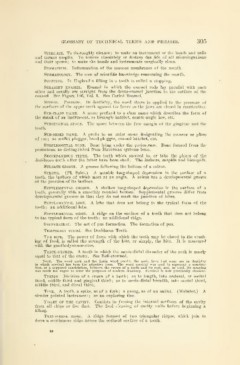Page 563 - My FlipBook
P. 563
GLOSSAEY OF TECHNICAL. TERMS AND PHRASES. 305
Sterilize. To thoroughly cleanse; to make an instrument or the hands and nails
and tissues aseptic. To remove absolutely or destroy the life of all microorganisms
and their spores; to make the hands and instruments surgically clean.
Stomatitis. Inflammation of the mucous membranes of the mouth.
Stomatologt. The sum of scientific knowledge concerning the mouth.
Stopping. In England a filling in a tooth is called a stopping.
Straight enamel. Enamel in which the enamel rods lay parallel with each
other and usually are straight from the dento-enamel junction to the aurface of the
enamel. See Figure 146, Vol. 1. See Curled Enamel.
Stress. Pres.?ure. In dentistry, the word stress is applied to the pressure of
tilt' surfaces of the upper teeth against the lower as the jaws are closed in niastication.
Sub-class name. A name prefixed to a class name which describes the form of
the shank of an instrument, as binangle hatchet, contra -angle hoe, etc.
Subgingival space. The space between the free margin of the gingivae and the
tooth.
Sub-order name. A prefix to an order name designating the manner or place
of use; as mallet plugger, hand-plugger, enamel hatchet, etc.
Subperiosteal bone. Bone lying xmder the periosteum. Bone formed from the
periosteum as distinguished from Haversian systems bone.
Succedaneous teeth. The teeth which succeed to, or take the places of the
deciduous teeth after the latter have been shed: The incisors, cuspids and bicuspids.
SuLCATE GROOVE. A groove following the bottom of a sulcus.
Sulcus. (PI. Sulci.) A notable long-shaped depression in the surface of a
tooth, the inclines of which meet at an angle. A sulcus has a developmental groove
at the junction of its inclines.
Supplemental groove. A shallow long-shaped depression in the surface of a
tooth, generally with a smoothly rounded bottom. Supplemental grooves differ from
developmental grooves in that they do not mark the junction of lobes.
Supplemental lobe. A lobe that does not belong to the typical form of the
tooth ; an additional lobe.
Supplemental ridge. A ridge on the surface of a tooth that does not belong
to the typical form of the tooth; an additional ridge.
StTPPUKATloN. The act of pus formation. The formation of pus.
Temporary teeth. See Deciduous Teeth.
The bite. The power of force with which the teeth may be closed in the crush-
ing of food, is called the strength of the bite, or simply, the bite. It is measured
with the gnathodynamometer.
Thick-necked. A tooth in which the mesio-distal diameter of the neck is nearly
equal to that of the crown. See Bell-crowned.
Note. The word neck and the Latin word cervix, the neck, have had some use in dentistry
in which cervical has been the adjective form. The word cervical was used to represent a constric-
tion, or a supposed constriction, between the crown of a tooth and its root, and, as used, its meaning
was much too va^e to serve the purposes of modem dentistry. Cervical is now practically obsolete.
Thirds. Division of a crown of a tooth ; as to length, into occlusal, or incisal
third, middle third and gingival third; as to mesio-distal breadth, into mesial third,
middle third, and distal third.
Tine. A tooth, a spike, as of a fork; a prong, as of an antler. (Webster.) A
slender pointed instrument; as an exploring tine.
Toilet op the cavity. Consists in freeing the internal surfaces of the cavity
from all chips or fine dust. The final cleaning of cavity walls before beginning a
filling.
Transverse ridge. A ridge formed of two triangular ridges, which join to
form a continuous ridge across the occlusal surface of a tooth.


